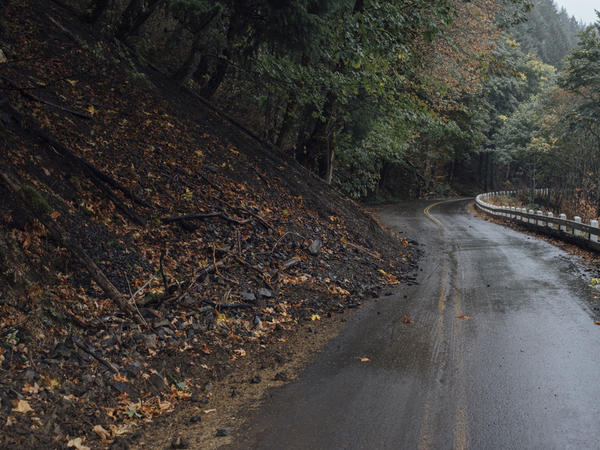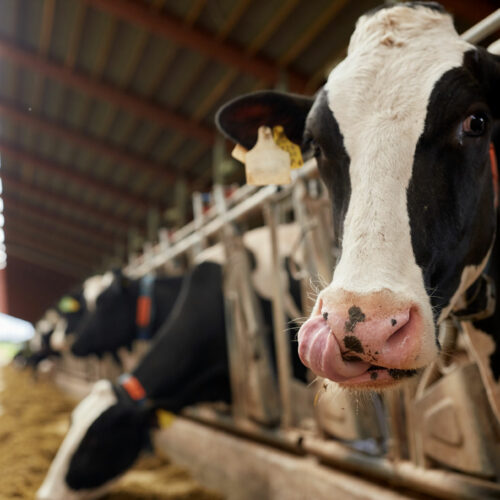
Rain Dampens Wildfires, But May Spur Landslides in Columbia Gorge
Listen
As heavy rains move into the Northwest, geologists are watching the Oregon side of the Columbia River Gorge. This summer’s wildfires have made slopes that are already prone to landslides even more treacherous.
Bill Burns is a top engineering geologist for the state of Oregon and an expert on landslides. He’s worried about the Gorge’s burned areas—plus rocks, mud and a healthy side of rain. He just knows too much.
In 1996, mud buried I-84 and the train tracks near the community of Dodson and flooded into the Columbia halting river traffic. A Prius-sized basalt boulder came down from the hillsides above.
And it’s still there. A sort of ominous reminder.
“That’s pretty big right?” Burns said. “So, imagine something like that coming at you at 30-40 miles an hour, inside of basically a wall of mud. Not much is going to survive.”
Burns would rather not be here.
“Definitely made me nervous,” he said.
Past landslides still haunting the Gorge
Burns said the Gorge is extra prone to landslides. There are basalt cliffs mixed with softer soil, all married with huge rainfall.
On a deeply-scratched field iPad, Burns showed off a map of the area. The slopes are lit up in bright colors. They indicate landslides have happened all around here before.

Old landslides are a prime indicator of where new slides can happen. Credit Ian C. Bates
And in the last decade, with new technology, scientists are seeing way more old landslides than they ever knew existed.
Old landslides are a prime indicator of where new slides can happen. And now many of those same areas have been roasted by this year’s wildfires. Little remaining vegetation means the ground has no shelter from the rain — and it might not drain fast enough. And that means the land may come sliding down.
“There are thousands of them in Oregon, so can’t name them all,” Burns said.
‘You might come here and think it’s safe’
The lodge is still closed at Multnomah Falls. So is the historic highway that gets people there. Wildfires burned off much of the moss and other vegetation that kept the basalt cliffs around the falls stable.
Rachel Pawlitz with the U.S. Forest Service said it’s not immediately clear how dangerous this whole area is.
“Oneonta is a good example of how you might come here and see some green trees and think it’s safe,” she said. “But higher up in the watershed it’s one of the most badly burned areas which is why we know that it’s got that risk for debris jams, floods and other things to come down through the creek.”
» Why moss is central to the danger at Multnomah Falls
But perhaps most worrying is where the rocks meet the road. In a spot called Shellrock Mountain, alongside Interstate 84 in the Columbia Gorge, a tide of recently-fallen rubble appears tumbled. Like half-blended margarita ice cubes. All the corners knocked off.
Protecting I-84
Stephen Hay is an engineering geologist for Oregon’s Department of Transportation. It’s his job to keep this major east-west corridor safe from landslides, rockfall and debris flows. About 23,000 vehicles pass through each day. Another 4,500 on the Columbia River Highway.
To protect the highway, the state and feds have piled massive sandbags along one edge and closed one lane to traffic.
But seeing what the mountain is capable of, you wonder whether its enough. Take the recent “tree toboggan.”
“We had a tree that was on fire come down the slope and ended up going through our retaining wall along here,” Hay said.
Hay said that burnt tree picked up so much speed it went through all the eastbound lanes of I-84 and pushed the center barrier too.
Hay flies through the Gorge with a helicopter pilot at least once a month on the lookout for fresh problem areas. Falling trees, stones and mud don’t give much warning. And they will be a problem for years now.
» Can area businesses handle another disaster?
So far, ODOT has spent nearly $500,000 just through September on fire fixes. Shellrock Mountain is just one spot on the interstate. There are thousands of burned acres in the Gorge.
And more rains are coming.
9(MDAyOTk4OTc0MDEyNzcxNDIzMTZjM2E3Zg004))
Related Stories:

Juez federal ordena a centrales lecheras de condado de Yakima analizar pozos y agua potable
Un juez federal del este de Washington concedió una orden judicial preliminar en una demanda que involucra a más de diez productores lácteos del condado de Yakima.

Think your light display is big? Check out Walla Walla’s ‘Christmas house’
Visiting the Long family’s light display has become a holiday tradition for many Walla Wallans. (Credit: Cali Long) Listen (Runtime 1:05) Read Drive down Walla Walla’s Wallula Avenue on a

Federal judge orders Yakima County dairies to test wells, drinking water
A federal judge in Eastern Washington granted a preliminary injunction in a lawsuit that
involves over ten Yakima County dairy producers.
















